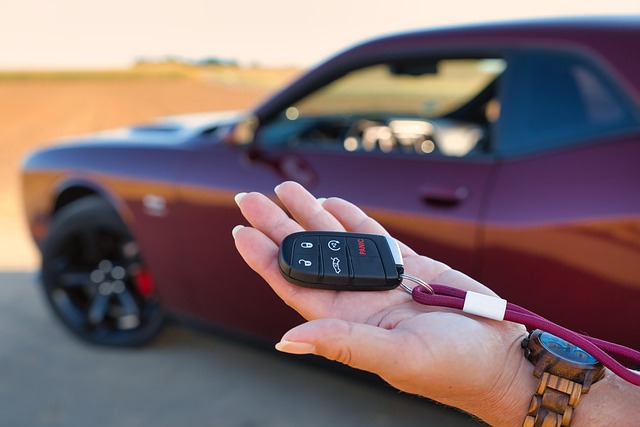Looking to register your car in California? This comprehensive guide walks you through every step, from understanding key requirements to submitting your application. First, grasp the essential rules around car registration in the Golden State. Next, gather crucial documents for a smooth vin (Vehicle Identification Number) verification process. Learn how this check ensures vehicle authenticity and complies with state laws. Then, select the right registration class based on your car’s type. Finally, master the application process and pay fees online or at a DMV office.
- Understand California Car Registration Requirements
- Gather Necessary Documents for VIN Verification
- Perform Vehicle Identification Number (VIN) Check
- Choose an Appropriate Registration Class
- Submit Application and Pay Fees
Understand California Car Registration Requirements

Before registering your car in California, it’s crucial to understand the state’s specific requirements. California requires a comprehensive set of documents and inspections to ensure that all vehicles on its roads are safe and legally compliant. One critical step is the verification of the vehicle’s unique identifier, known as the Vehicle Identification Number (VIN). This process, often referred to as VIN verification, plays a pivotal role in authenticating your car’s history and compliance with emission standards.
A key aspect of this process involves ensuring that the vehicle has passed necessary safety and emissions inspections. California offers both static and mobile vin inspection services, allowing for flexibility in how you confirm your car’s eligibility. Mobile vin verification, provided by specialized services, can be particularly convenient, as it brings the inspection directly to your location, saving time and effort. This meticulous approach guarantees that only cars meeting all standards are granted registration, thereby enhancing road safety and environmental protection.
Gather Necessary Documents for VIN Verification

Before you begin the registration process in California, it’s crucial to gather all the essential documents for VIN (Vehicle Identification Number) verification. This includes your vehicle’s registration from the previous state, a valid driver’s license, proof of insurance, and proof of ownership, such as a purchase agreement or title document. Additionally, you’ll need to provide a completed California Vehicle Registration Application form.
For a streamlined process, consider using a mobile VIN verification service. These services can facilitate the collection of necessary data by scanning your vehicle’s VIN and verifying its history digitally, including checking for any outstanding recalls or defects. A mobile VIN inspector can also help you navigate the paperwork and ensure that all documents are in order before heading to the California Department of Motor Vehicles (DMV) office.
Perform Vehicle Identification Number (VIN) Check

Before you begin the registration process, it’s crucial to perform a Vehicle Identification Number (VIN) check. This step is essential for verifying that your vehicle’s details match its identification number, which is unique and can be used for historical records and tracking purposes. A VIN inspection ensures that there are no discrepancies between the information on the car’s title, registration documents, and the actual vehicle.
One convenient option is to opt for a mobile VIN verification service. These services allow you to complete the check quickly and efficiently from the comfort of your home or even while waiting in line at the DMV. A mobile vin inspection can save time and eliminate the need to visit a dealership or specialized shop, making the registration process smoother for California residents.
Choose an Appropriate Registration Class

When registering your car in California, understanding your vehicle’s classification is crucial. The state offers various registration classes tailored to different types of vehicles. This process involves a thorough vin verification (vehicle identification number) to ensure accuracy. Start by checking if your car falls under standard passenger vehicles, light trucks, or specialized categories like motorcycles or classic cars. Each class has specific requirements regarding age, emissions standards, and safety features, impacting the registration fees you’ll pay.
For a smoother process, consider utilizing mobile vin verification services, which offer convenient vin inspection on-site. These mobile verifiers can help ensure your vehicle’s eligibility for the appropriate registration class, making it easier to navigate California’s registration guidelines.
Submit Application and Pay Fees

After ensuring your vehicle meets all necessary requirements, it’s time to submit your application and fees for car registration in California. This crucial step involves completing an official form, typically available at the California Department of Motor Vehicles (DMV) website or local field offices. Accurately filling out the form requires your vehicle’s unique identification number, known as the Vehicle Identification Number (VIN), which undergoes a meticulous vin verification process. This involves cross-referencing the VIN with the manufacturer’s records to ensure the vehicle’s history and specifications match what is declared on the registration application.
To streamline this process, many California residents opt for convenient services like mobile vin inspection or mobile vin verification. These options dispatch a professional to your location to perform the necessary VIN check using specialized equipment, eliminating the need to visit a DMV office. Once the form is complete and fees are paid, which may vary based on vehicle type and other factors, you’re one step closer to officially registering your car in California, ensuring compliance with state regulations and potentially enjoying simplified maintenance and registration processes in the future.
Registering a car in California involves several steps, from understanding requirements to completing a vehicle identification number (VIN) check. Ensure you gather all necessary documents, choose the right registration class, and submit your application along with the required fees. A successful VIN verification is key to ensuring compliance and securing your vehicle’s legal status in the Golden State.
